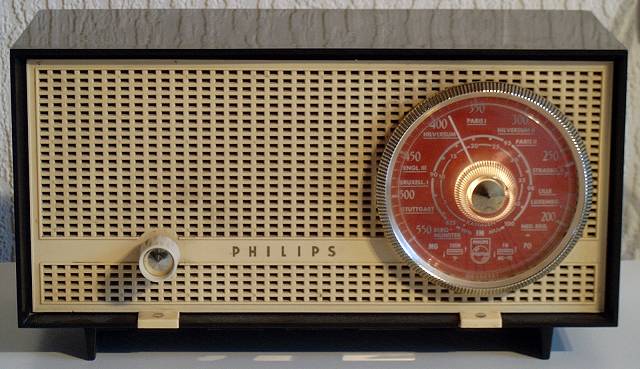





 1959
1959 1959
1959 1959
1959 |
Cabinet: | 80% |
 |
Reception AM: | 80% |
 |
Reception FM: | 70% |
 |
Sound Quality AM: | 50% |
 |
Sound Quality FM: | 50% |
 |
Sound Quality P.U.: | 50% |
 |
P.U. Entrance: | Yes |
 |
Tape Recorder Entrance: | No |
 |
Extra Loudspeaker Output: | No |
 |
Loudness: | No |
 |
Treble Control: | Yes, switchable |
 |
Bass Control: | No |
 |
Tone Register Switches: | No |
 |
AM Bandwidth Switch or Control: | No |
 |
Tuning Indicator: | No |
 |
Build-in Antenna: | Yes, MW plate antenna |
 |
Build in Ferrite or Window Antenna: | No |
 |
Separate AM/FM tuning: | No |
 |
Tubes: | ECC85, ECH81, EF89, UABC80, UL84, UY85. |
 |
Wave Bands: | MW, FM from 87.5 - 100 MHz |
 |
Intermediate Frequencies (IF): | 452 kHz, 10.7 MHz |
 |
Loudspeaker: | AD 1400 W |
 |
Resonance Frequency Fs: | ? |
 |
Frequency Range Power Amplifier: | ? |
 |
RMS Output Power at 5 Ohms: | ? |
 |
Cabinet: | Bake-lite, dark brown. |
 |
Dimensions: | 29.5 x 15.5 x 14 cm |
 |
Mains Power Voltages: | 110, 127, 220 Volts~ |
 |
Mains Power Consumption | 45 Watts |
 |
Retail Price | ? |
The UL84 shows blackened traces on the glass due to overload, but the UL84 is OK and there is no positive grid voltage.
 Home
Home Back
to Picture Gallery 3
Back
to Picture Gallery 3 Contact
Kees van Dijke
Contact
Kees van Dijke Download
the schematic diagram
Download
the schematic diagram